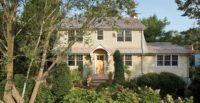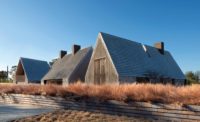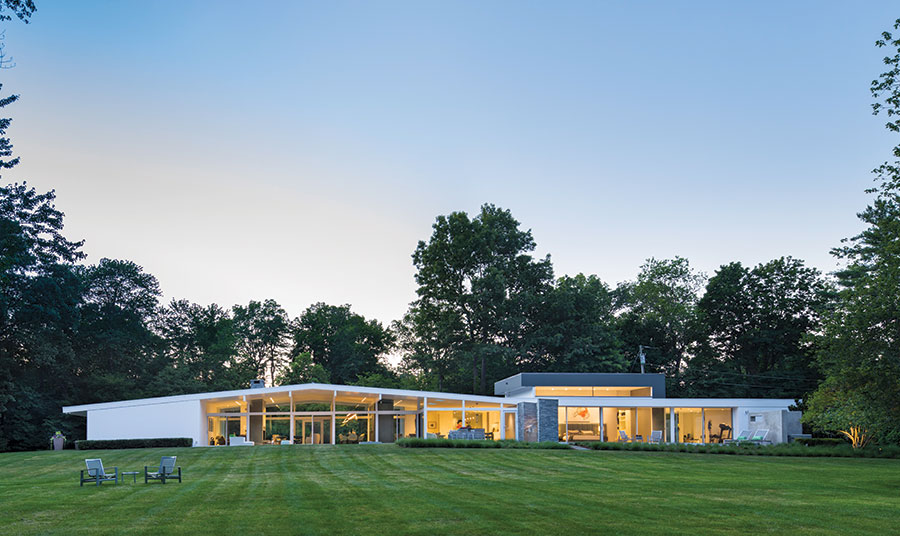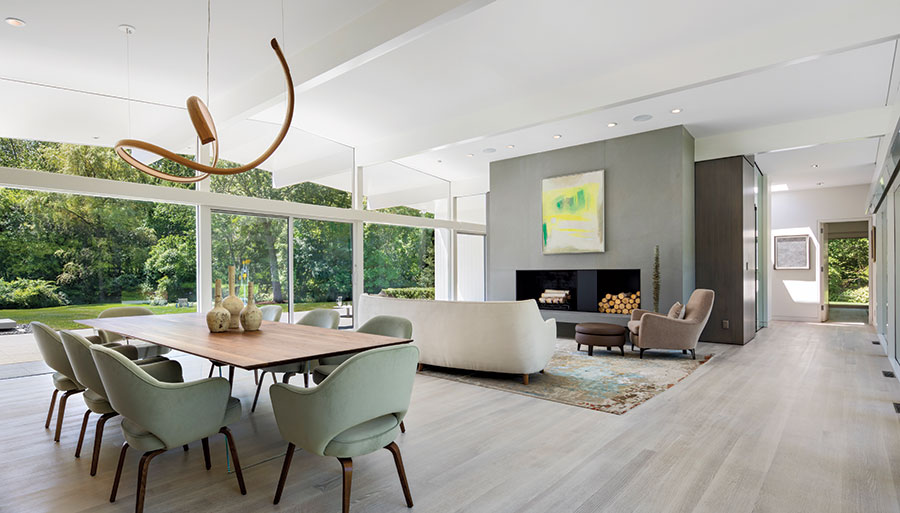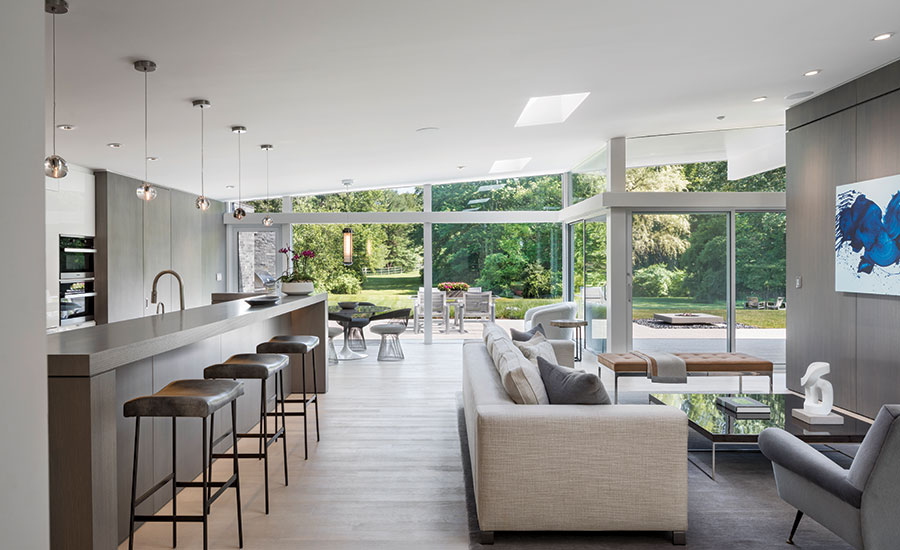New Canaan House by Joel Sanders
New Canaan, Connecticut

In renovating and expanding a 1957 modern house designed by John Black Lee in New Canaan, Connecticut, architect Joel Sanders extended the eastern end of the house as a linear bar.
Photo © Peter Aaron / OTTO

He opened up the existing living areas by removing shoji screens and installing gray-stained white ash storage cores that are pulled back from the glazed enclosing walls. As a result, elongated aisles along north and south perimeters amplify the flow of the space.
Photo © Peter Aaron / OTTO

The new wing, discreetly clad in Canadian bluestone, is the first thing visitors see approaching the house. The existing entrance is separated from the driveway by a fence of Cor-Ten steel slats.
Photo © Peter Aaron / OTTO

With the family room, Sanders enlarged the kitchen and created a breakfast space.
Photo © Peter Aaron / OTTO

The master bedroom in the extension has a 12-foot-high ceiling, clerestory windows, and an outdoor terrace defined by a bluestone wall.
Photo © Peter Aaron / OTTO

Image courtesy Joel Sanders Architect






Architects & Firms
A design-oriented client acquiring a Midcentury Modern house often finds that the prospective “renovation” turns into “reconstruction.” The typical one-story open-plan dwellings were built with experimental materials and techniques that may not have worn well. Another drawback is the paltry size of the bathrooms and kitchens, which were planned for extreme efficiency in the postwar era, geared to a household without hired help. Tastes change, and those areas now need to be enlarged and updated.
Additional Content:
Jump to credits & specifications
When a 1957 house by the Modernist architect John Black Lee came on the market in New Canaan, Connecticut, a few years ago, a couple, impressed by the pristine condition of the house and by its expansive 2.8-acre grounds, seized the chance to buy it. They knew of Lee (1924–2016), who had built more than a half-dozen houses in New Canaan. He had a strong affinity to the Harvard Five, a group of Graduate School of Design alumni and teachers (Marcel Breuer, Philip Johnson, John Johansen, Landis Gores, and Eliot Noyes), who had settled in the Connecticut town in the 1940s and were responsible for a number of significant residences there. Although Lee had a B.A. from Brown University, he had learned architecture and construction through apprenticeships, including at Noyes’s firm, before starting his own practice in 1954.
The clients, Mark Ullman and Taylor Gibson- Ullman, who bought Lee’s long, low, steel-and- wood house, were lucky that it proved to be solid and sturdy. But it did have small bathrooms and a cramped kitchen—and they desired more space. The architect they hired, Joel Sanders, who is based in New York and teaches at Yale’s School of Architecture in nearby New Haven, understood the challenge. “The owners wanted to keep the aura of the house,” says Sanders. “But the question was, how do you renovate and expand sensitively?”
The original 3,600-square-foot house has a shallow gable roof, unlike the flat roofs typical of the period, and is glazed on both long sides. The architect retained the exterior much as it was, only demolishing a small portion of the east end where the original house joins the addition. Deferring to site conditions, Sanders designed it as an extended 2,600-square-foot linear bar to accommodate the new master bedroom, bath, gym, and garage.
To avoid replicating the original roof shape yet give a 12-foot height to the master suite, Sanders inserted into the bar a simple vertical volume that pushes up above the new flat roof. Clerestory windows around this structure admit daylight, and glass doors on the south open off the bedroom to an outdoor terrace. The architect introduced a new material to the composition—bluestone, of an almost charcoal hue, which forms a wall extending from the terrace perpendicular to the wing. Similarly, bluestone cladding on the addition’s front facade further identifies it as an entity separate from the original structure. To unite the new and the old portions of the house, Sanders also “extruded,” as he puts it, the original roof line along the entire length of the rectilinear wing, which reads as a white fascia.
The new stone-clad expansion is what a visitor driving onto the property sees first, but the architect kept the entrance to the original house where it was: it now overlooks a landscaped garden. Inside, he retained the clarity of Lee’s central volume while further emphasizing its openness by removing partitions, including shoji screens that had separated the various living areas. Gray-stained white ash clads storage units and the fireplace core; these subdivide the open spaces between the living room and family/kitchen area. On the west end, the existing three-bedroom wing remains. While this area has been kept intact, some adjustments (e.g., glass showers instead of bathtubs) make the two baths seem more spacious. The rooms themselves are designed for flexible uses, since the three sons are in the process of leaving home. Here, as in the rest of the house, the client worked with Ampersand Architecture, Architect of Record, and Dana Lyon of the Refined Group on the interior furnishings.
The final result is a new expansion that is discrete, yet handsomely complements the original Lee design. By his manipulation of rectilinear planes and use of stone and wood, Sanders has made the living spaces contemporary and comfortable while dramatizing Lee’s contribution to Midcentury Modern.
CreditsDesign Architect: JSA (Joel Sanders Architect), 89 5th Avenue Suite 301 New York, NY 10003, 212-431-8751, www.joelsandersarchitect.com
Personnel in architect's firm who should receive special credit: Joel Sanders, RA, AIA, Josh Dannenberg, RA, Marco Li
Architect of record: Ampersand Architecture, 648 Broadway, Suite 912, New York, NY 10012, (212) 777-1276, www.ampersandarchitecture.com
Landscape Architect Wagner Hodgson – Landscape Architecture, 430 Warren Street Hudson, NY 12534, 518.567.1791, http://www.wagnerhodgson.com
Interior Designer: Ampersand Architecture, 648 Broadway, Suite 912, New York, NY 10012, (212) 777-1276, www.ampersandarchitecture.com; Dana Lyon of the Refined Group; Taylor Gibson-Ullman and Ian Veidenheimer creative consultants
Engineers Structural: Robert Sillman Associates, 32 Old Slip, 10th Floor, New York, NY (212) 620-7970, www.silman.com MEP: CES Engineering LLC, 216 East 45th Street, Suite 1107, New York, NY 10017, (646) 691-3999, www.cesct.com Civil: [Peak Engineering LLC, 4 Old Mill Road, Redding, CT 06829, (203)834-0588, www.peakengineersllc.com
General contractor: Rico Imbrogno, Carcole Construction LLC, 170 Selleck Street, Stamford, Ct 06902 (203)504-8182
Photographer: Peter Aaron |
SpecificationsExterior Cladding Masonry: K2, Pacific Ashlar Thin Stone Veneer Wood: V-groove to match generic existing Moisture barrier: Grace Ice and Water Shield Other cladding unique to this project: Trim Boards- Azek
Roofing Metal: Generic flashing
Windows Metal frame: Arcadia 5000 window and door system
Glazing Glass: Vitro Architectural Glass Skylights: Existing
Doors Entrances: Arcadia, custom Metal doors: Arcadia 5000 window and door system Wood doors: Solid Core Painted Sliding doors: Solid Core Painted
Special doors: Electric Dog Door: Hitec Pet, PX-1 Guest Bathroom Slider Shower Doors: Kohler
Hardware Locksets: Accurate Hardware, custom to match existing Closers: Blum Pulls: Sugastune, Accurate, Hafele, Nemeeks, Richelieu Other special hardware: Art/TV lift: Motivated Design, Art and Panel Lift
Interior Finishes Cabinetwork and custom woodwork: Wood: Ash, custom stained and made by Eldridge Wood Design High Gloss Millwork: Custom made in Eurocase by Eldridge Wood Design
Paints and stains: Interiors: Benjamin Moore Regal Select, custom mix Exteriors: Benjamin Moore Regal Select Exterior, custom mix Solid surfacing: Pental Quartz, super white honed Special surfacing: Wood flooring was custom Floor and wall tile: Kitchen Backsplash: Ann Sacks, Clodagh Core SW wall tile. Floors GTSTILE Traverertini Silver G. Bath 1: Artistic Tile Ambra Gris wall tile, Stone Stone Source Cesi Bianco G. Bath 2: Porcelanosa, Ruggine Alumnio, Stone Stone Source Cesi Bianco Master Bathroom: AKDO Ceramics, Heavy Rain Carrera Polish, Floor REFIN Oxyde Light Powder Rm: Stone Source Phenomenon Aire Bianco, Floor KTM Ergon Elegance Special interior finishes unique to this project: Gym Floor: Fastfloor Alesso Soft Floors in lime High Gloss Cabinetry: Eurocase, Reflekt High Gloss in white
Furnishings Office furniture: None, all office furniture was custom Fixed seating: Minotti sofa, Nicos Zographos bench (1970s), Custom curved sofa (Studio Van den Akker) Chairs: Milo Baughman Vintage swivel chairs (1970s – Todd Merrill), Gio Ponti style chairs (1950s Italian, Van Den Akker), Larsen Seal Chair (1956), Knoll Platner chairs, Nani Dietzel ring chairs, Knoll Saarinen chairs, Minotti chairs Tables: Adrian Pearsall coffee table (1950s), Knoll Saarinen table, Minotti coffee table, Custom John Ford artisan dining table, Minotti Jacob coffee table in Calcutta marble Upholstery: Knoll, Holly Hunt Fabrics Other furniture: Custom Master bed (Holly Hunt fabrics), Paola Lenti (outdoor furniture)
Lighting Interior ambient lighting: John Procario light sculpture (dining chandelier), Gio Ponti lighting (kitchen table) Downlights: WAC, JUNO Exterior: SPJ Lighting various Dimming system or other lighting controls: Control 4 M. Bathroom Vanity: Aamasco #360T514SM
Plumbing Faucet: Grohe Vanity/Sink: Porcelanosa Drains: Schluter
Master Bathroom Faucet: Hansgrohe Sink: Duravit Drains: Schluter Tub: Victoria + ALbert Toilet: Duravit Washlet: Duravit
Powder Room Faucet: Aqua Brass Sink: Duravit
Kitchen: Faucet: Rohl Sink: Julien Appliances Ovens: Miele Hood: Miele Cooktop: Miele Dishwasher: Miele and FisherPaykel Refrigerator: Miele Wine Chiller: Perlick Exterior Oven: Lynx |


